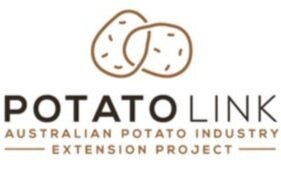Dean, Vic Demonstration Trial: Nitrogen inhibitors and responsive fertiliser programs
Scroll down for updates
Background
Photo: Jacob Berends
While fertiliser prices have reduced in recent years, the cost of production is still placing pressure on the gross margins of potato growers. Improving input use efficiency through either a reduction in the application of products or the increase in yield is a high priority.
The potato industry has been exploring the use of nitrogen inhibitors to improve nitrogen use efficiencies. PotatoLink conducted a small demonstration last year in Springbank, with results suggesting there was some impact on the size of potatoes and positive impact on nitrogen use efficiency.
Photo: Jacob Berends
Nitrogen inhibitors inhibit nitrifying bacteria in the soil, slowing down the conversion of ammonium N to nitrate which is more prone to loss. With conventional nitrogen fertilisers, ammonium N is converted to nitrate N in 1-3 weeks. Heavy rain or irrigation can cause any nitrate N that hasn’t been taken up to be lost through leaching in sandy soils – or through denitrification in heavier soils.
Photo: Jacob Berends
As nitrogen inhibitors can delay nitrate availability, there is the potential for nitrogen to be delivered later in the crop cycle when crop nitrogen demand is higher. This may reduce the amount, or need for top dressing with nitrogen which can often be inefficient due to product not being able to be delivered to the root system of the crop. There are also reports of the ability to reduce nitrous oxide emissions.
Sap and tissue tests are incredibly useful tools for managing potato nutrition. Mainly through identifying crop nutrient use and allowing for a responsive nutrition program. Through the demonstration site we want to develop a methodology that industry can pick up and adopt.
Trial Plan
The primary objectives of the trial are to:
Evaluate the impact of using Nitrogen Inhibitor base fertilisers at different rates on potato crop yield (marketable tuber weight), quality (size distribution, defects and specific gravity), and gross margins.
Compare a crop sampling-based responsive fertiliser program with a conventional fertiliser program to determine their effectiveness in optimising fertiliser use and profitability over a single growing season
By considering these factors, this demonstration trial aims to provide valuable insights into optimising fertiliser management strategies for the Victorian potato industry. More efficient fertiliser practices, can help growers reduce costs, improve environmental outcomes, and maintain healthy, high-yielding crops while supporting the long-term viability of their farming operations.
Updates
November 2024
The site has been planted and treatments applied.
Trial site November 29th 2024 - Jacob Berends
January 2024
Saps sample taken. Plants not yet at canopy closure but are starting to initiate some tubers.
Photos and video: Jacob Berends
No nitrification inhibitor
Standard rate
Low rate
High Rate
February 2025
We explored nitrogen use efficiency and the development of responsive nutrition programs through in-season testing. This session focused on optimising nutrient management to boost potato crop productivity and sustainability. The team discussed practical approaches to refining fertiliser use, promoting healthier soils, and enhancing overall crop performance.
April 2025
The site has been harvest for each of the treatments 5 plots were dug. Digs were 3 meters of one row. Tubers were then sized and graded for marketability, weighed and sub samples were taken for Specific Gravity measurements. Results will be analysed and published in the magazine and PotatoLink website.
More Information
To track the progress of this demonstration trial, stay tuned on the PotatoLink website, e-bulletin and social media channels.
Or contact Stuart Grigg, Regional Representative, PotatoLink, stuart.grigg@potatolink.com.au or Ryan Hall, Horticultural Researcher, Applied Horticultural Research, ryan.hall@ahr.com.au
